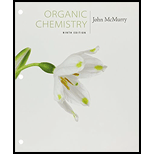
Interpretation:
The stereochemistry of the following pericyclic reactions,
a) The thermal cyclization of a conjugated tetraene.
Concept introduction:
a) A pericyclic reaction is a concerted reaction that proceeds through a cyclic transition state. Pericyclic reactions are completely stereospecific; that is, a single stereoisomer of the reactant forms a single stereoisomer of the product. Various kind of stereochemistry occurs in pericyclic reaction.
Interpretation:
The stereochemistry of the following pericyclic reactions,
b) The photochemical cyclization of a conjugated tetraene.
Concept introduction:
b) When like phases of the p orbitals are on the same side of the molecule, the two orbitals must rotate in opposite directions—one clockwise and one counterclockwise. Rotation in opposite directions is said to be disrotatory.
Interpretation:
The stereochemistry of the following pericyclic reactions,
c) A photochemical [4 1 4] cycloaddition.
Concept introduction:
c) When like phases of the p orbitals are on opposite sides of the molecule, the two orbitals must rotate in the same direction—both clockwise or both counterclockwise. Rotation in the same direction is said to be conrotatory.
Interpretation:
The stereochemistry of the following pericyclic reactions,
d) A thermal [2 1 6] cycloaddition.
Concept introduction:
d) A suprafacial stereochemistry occurs when like phases of the p orbitals of both reactants are on the same side of the pie system, so that two bonding interactions result.
Interpretation:
The stereochemistry of the following pericyclic reactions,
e) A photochemical [3, 5] sigmatropic rearrangement.
Concept introduction:
e) An antarafacial stereochemistry occurs when one pie system must twist to align like phases of the p orbitals of the terminal carbons of the reactants.
Trending nowThis is a popular solution!

Chapter 30 Solutions
Student Value Bundle: Organic Chemistry, + OWLv2 with Student Solutions Manual eBook, 4 terms (24 months) Printed Access Card (NEW!!)
- Submit Problem 3 of 10 Draw the major product of this reaction. Ignore inorganic byproducts and the amine side product. O 'N' NH 1. NaOH, heat 2. Neutralizing work-up Select to Drawarrow_forwardb) Certain cyclic compounds are known to be conformationally similar to carbohydrates, although they are not themselves carbohydrates. One example is Compound C shown below, which could be imagined as adopting four possible conformations. In reality, however, only one of these is particularly stable. Circle the conformation you expect to be the most stable, and provide an explanation to justify your choice. For your explanation to be both convincing and correct, it must contain not only words, but also "cartoon" orbital drawings contrasting the four structures. Compound C Possible conformations (circle one): Детarrow_forwardLab Data The distance entered is out of the expected range. Check your calculations and conversion factors. Verify your distance. Will the gas cloud be closer to the cotton ball with HCI or NH3? Did you report your data to the correct number of significant figures? - X Experimental Set-up HCI-NH3 NH3-HCI Longer Tube Time elapsed (min) 5 (exact) 5 (exact) Distance between cotton balls (cm) 24.30 24.40 Distance to cloud (cm) 9.70 14.16 Distance traveled by HCI (cm) 9.70 9.80 Distance traveled by NH3 (cm) 14.60 14.50 Diffusion rate of HCI (cm/hr) 116 118 Diffusion rate of NH3 (cm/hr) 175.2 175.2 How to measure distance and calculate ratearrow_forward
- For the titration of a divalent metal ion (M2+) with EDTA, the stoichiometry of the reaction is typically: 1:1 (one mole of EDTA per mole of metal ion) 2:1 (two moles of EDTA per mole of metal ion) 1:2 (one mole of EDTA per two moles of metal ion) None of the abovearrow_forwardPlease help me solve this reaction.arrow_forwardIndicate the products obtained by mixing 2,2-dimethylpropanal with acetaldehyde and sodium ethoxide in ethanol.arrow_forward
- Synthesize 2-Ethyl-3-methyloxirane from dimethyl(propyl)sulfonium iodide using the necessary organic or inorganic reagents. Draw the structures of the compounds.arrow_forwardSynthesize 2-Hydroxy-2-phenylacetonitrile from phenylmethanol using the necessary organic or inorganic reagents. Draw the structures of the compounds.arrow_forwardSynthesize N-Methylcyclohexylamine from cyclohexanol using the necessary organic or inorganic reagents. Draw the structures of the compounds.arrow_forward
- Synthesize N-Methylcyclohexylamine from cyclohexanol using the necessary organic or inorganic reagents. Draw the structures of the compounds.arrow_forwardIf possible, please provide the formula of the compound 3,3-dimethylbut-2-enal.arrow_forwardSynthesize 1,4-dibromobenzene from acetanilide (N-phenylacetamide) using the necessary organic or inorganic reagents. Draw the structures of the compounds.arrow_forward
